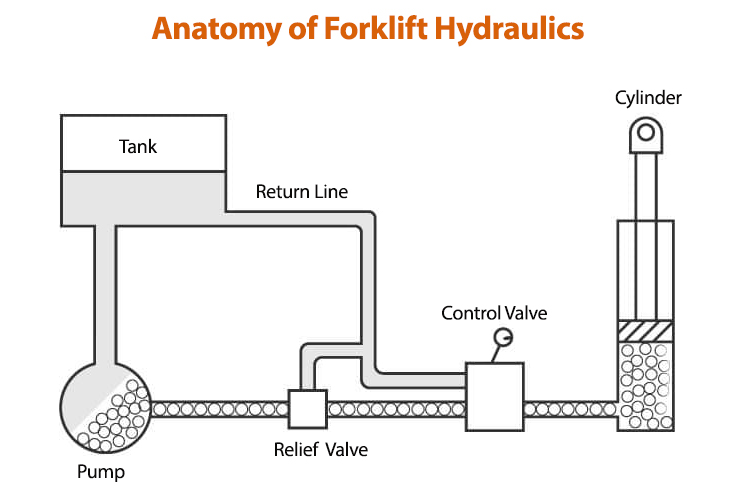Forklift Maintenance & Understanding the Hydraulic System
The primary function of a forklift is to lift, transport, and deposit a load safely. Without the “lift,” well, a forklift is just another truck. But what gives the power to the lift function? That’s where the hydraulics system enters the conversation. The hydraulics system generates the force needed to raise and lower the forks or forklift attachments that secure the load. It consists of several components working in concert to achieve the desired result.
Given the significance of the hydraulic system for dependable forklift operation, it is vital to understand how it works and how to perform proper forklift maintenance.
How Do Forklift Hydraulics Work?
Forklift hydraulics use pressurized fluid to generate movement. Hydraulic fluid is stored in a reservoir tank that feeds into the hydraulic pump. The pump pushes the hydraulic fluid through a control valve to the lift cylinders through a series of hoses. The pressure then pushes against the cylinder, which moves the forklift forks.
The advantage of hydraulics lies in Pascal’s Law which creates large force from relatively low pressure. To calculate the hydraulic advantage, the force exerted is equal to the pump pressure (in psi) x surface area of the cylinder. For example, a hydraulic system with a system pressure of 1000psi pushing against a cylinder with a surface area of 10 square inches provides a lifting force of 10,000 lbs!
Of course, the exact load capacity will vary based on forklift size, model, and other variables… but you get the idea.
Critical Components of Forklift Hydraulics

There are several critical elements in a forklift’s hydraulic system, including:
- Tank – Usually embedded into the forklift frame, the tank is the container that holds the hydraulic fluid.
- Pump – The hydraulic pump is responsible for pushing the fluid in one direction and maintaining a steady flow.
- Control Valve – The control valve regulates flow direction to raise, lower, or hold the load.
- Relief Valve – The relief valve prevents the system from experiencing excess pressure, resulting in ruptured hoses, leaking connections, or potential safety issues; it is a necessary and vital safety feature in forklift hydraulics.
- Cylinder – The cylinder translates the flow of the hydraulic fluid into movement.
- Return Line – The return line reroutes the fluid to the tank after the pressure is released and the forklift’s forks go down.
Forklift hydraulics typically use either water-based, oil-based, or synthetic fluids. Each has its advantages and drawbacks that you’ll want to consider when evaluating forklift models. For example, water-based options are more fire-resistant, but synthetic varieties are helpful for high-temperature systems.
Important Routine Hydraulic Forklift Maintenance Tips
Like other types of forklifts, hydraulic lift vehicles require routine maintenance. Some of the essential tasks include:
- Replace fluid in the tank approximately every 4,000 hours.
- Change the hydraulic filter approximately every 2,000 hours.
- Check the cylinders for air or fluid leaks.
- Examine the pump for routine or premature wear and tear.
- Inspect the seals for rotting and cracking.
- Inspect forklift forks & chains for safe operation
Apex is ready to help keep your forklift running on all literal and figurative cylinders. Our fleet maintenance program ensures regular, full-service inspection and forklift maintenance of electric and internal combustion (IC) vehicles by certified, trained technicians.
Addressing Common Forklift Hydraulics Repair Issues

Forklift repair issues can be identified through various tell-tale signs, such as odd sounds, slow or distressed movement and operation, and overheating (when fluid temperatures exceed 180 degrees Fahrenheit). Some of the most common repair issues associated with forklift hydraulics often include:
- Leaking Hoses – Forklift hydraulic systems rely on hoses to rotate fluid pressure. These hoses can break down, wear out and crack over time. Other factors that can lead to hose leaks include using the wrong type of fluid and incorrectly installing hoses within the hydraulics system.
- Mast Drift – Mast drift can be extremely dangerous and involves the gradual and unwanted movement of the forklift’s mast while it’s extended. If the problem continues, it can cause the forklift to tip over or collapse.
- Suction Filter Clogs – A forklift hydraulics system is equipped with suction filters to help capture harmful particulates and impurities in the fluid. It’s essential to change these filters regularly, so they don’t get clogged and decelerate or stop fluid flow.
It’s important to have experienced, factory-trained technicians diagnose and service your forklift’s hydraulics system. Failure of any hydraulic component in the lift system can result in a sudden movement, causing product damage, injury, or death if proper hosing, filters, or other components are incorrectly installed, or the wrong or inferior parts are used. Call Apex for forklift maintenance you can count on, guaranteed. We are a leading, trusted warehouse vehicle resource servicing the broad Chicago metro area.
Let Apex Take the Pressure Off
You’ve got a lot riding on how well your forklifts operate. From the hydraulics to the tires, batteries, and more, no one knows warehouse vehicle maintenance better than the Apex team. Our factory-trained, certified technicians will inspect, diagnose, repair your vehicles quickly and get your team back up and running safely and efficiently. See our full menu of repair and maintenance services. Check out our extensive inventory of repair and replacement parts. We also offer operator training and certification courses to ensure safe, professional control of your forklifts. Contact us today to learn more about how Apex can help you meet your productivity goals.
